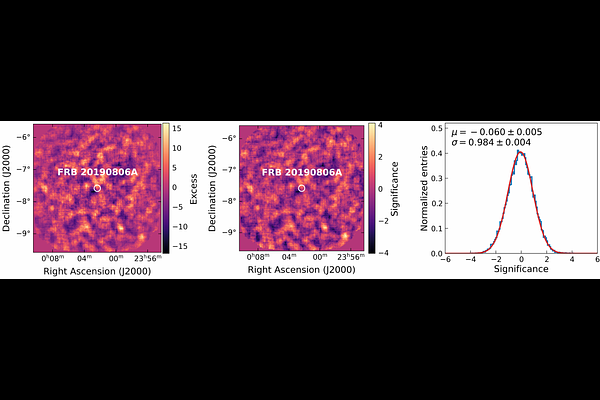H.E.S.S. programme searching for VHE gamma rays associated with FRBs

H.E.S.S. programme searching for VHE gamma rays associated with FRBs
F. Aharonian, A. Archaryya, J. Aschersleben, H. Ashkar, M. Backes, V. Barbosa. Martins, R. Batzofin, Y. Becherini, D. Berge, K. Bernlöhr, M. Böttcher, C. Boisson, J. Bolmont, M. de. Bony. de. Lavergne, J. Borowska, F. Bradascio, R. Brose, A. Brown, F. Brun, B. Bruno, C. Burger-Scheidlin, S. Casanova, J. Celic, M. Cerruti, T. Chand, S. Chandra, A. Chen, J. Chibueze, O. Chibueze, J. Damascene. Mbarubucyeye, J. de. Assis. Scarpin, A. Djannati-Ataï, J. Djuvsland, A. Dmytriiev, K. Egberts, S. Einecke, J. -P. Ernenwein, C. Escañuela. Nieves, M. Filipovic, G. Fontaine, S. Funk, S. Gabici, J. F. Glicenstein, J. Glombitza, G. Grolleron, B. Heß, W. Hofmann, T. L. Holch, M. Holler, D. Horns, Zhiqiu. Huang, A. Jaitly, M. Jamrozy, F. Jankowsky, I. Jung-Richardt, E. Kasai, K. Katarzyński, D. Kerszberg, R. Khatoon, B. Khélifi, W. Kluźniak, Nu. Komin, K. Kosack, D. Kostunin, A. Kundu, R. G. Lang, S. Le. Stum, A. Lemière, M. Lemoine-Goumard, J. -P. Lenain, A. Luashvili, J. Mackey, D. Malyshev, V. Marandon, R. Marx, A. Mehta, M. Meyer, A. Mitchell, R. Moderski, M. O. Moghadam, E. Moulin, M. de. Naurois, J. Niemiec, P. O'Brien, L. Olivera-Nieto, E. de. Ona. Wilhelmi, M. Ostrowski, S. Panny, M. Panter, R. D. Parsons, U. Pensec, S. Pita, G. Pühlhofer, M. Punch, A. Quirrenbach, S. Ravikularaman, M. Regeard, O. Reimer, H. Ren, B. Reville, F. Rieger, G. Rowell, B. Rudak, K. Sabri, V. Sahakian, H. Salzmann, A. Santangelo, M. Sasaki, J. Schäfer, F. Schüssler, H. M. Schutte, J. N. S. Shapopi, A. Sharma, S. Spencer, Ł. Stawarz, R. Steenkamp, S. Steinmassl, C. Steppa, T. Takahashi, T. Tanaka, M. Tsirou, C. van. Eldik, M. Vecchi, C. Venter, T. Wach, S. J. Wagner, A. Wierzcholska, A. A. Zdziarski, A. Zech, N. Żywucka
AbstractFast Radio Bursts (FRBs) are highly energetic, extremely short-lived bursts of radio flashes. Despite extensive research, the exact cause of these outbursts remains speculative. The high luminosity, short duration, and high dispersion measure of these events suggest they result from extreme, high-energy extragalactic sources, such as highly magnetized and rapidly spinning neutron stars known as magnetars. The number of detected FRBs, including repeating ones, has grown rapidly in recent years. Except for FRB 20200428D, and FRB-like radio burst that is associated to Galactic magnetar SGR 1935+2154, no multi-wavelength counterpart to any FRB has been detected yet. The High Energy Stereoscopic System (H.E.S.S.) telescope has developed a {program} to follow up FRBs searching for their gamma-ray counterparts, helping to uncover the nature of FRBs and FRB sources. This paper provides an overview of the searches for FRB sources conducted by H.E.S.S., including follow-up observations and simultaneous multi-wavelength campaigns with radio and X-ray observatories. Among the FRB sources observed by H.E.S.S., nine are localized with redshifts ranging between 0.11 and 0.492 from 2015 to 2022. No significant very high energy (VHE) emission was detected during these observations. We report constraints on the VHE luminosity ranging from $10^{44}$ erg s$^{-1}$ and $10^{48}$ erg s$^{-1}$, placing limits on the FRB's region persistent VHE emission and potential FRB afterglow emission across timescales from hours to years.